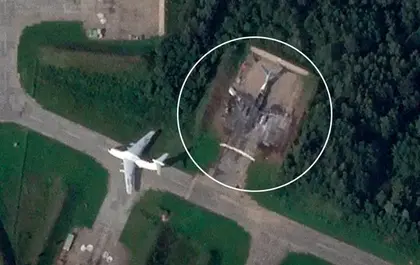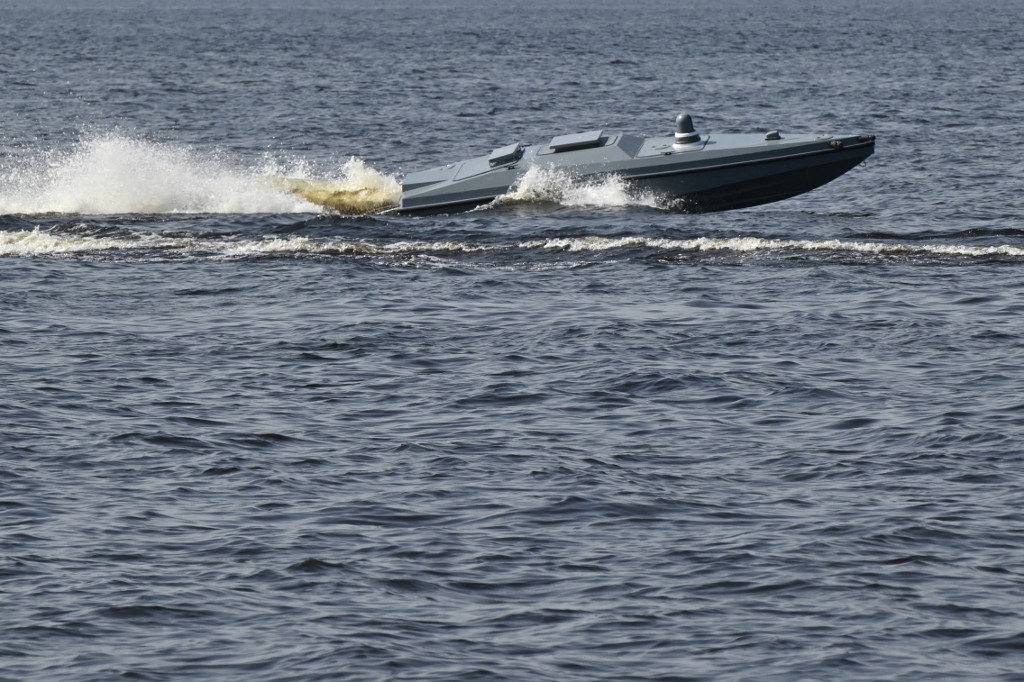Ukraine’s success in the recent targeting of Moscow’s long-range air fleet is forcing the Russian Air Force to move their strategic aircraft to airfields far from Ukraine or risk their loss.
Destroying and even simply damaging Russia’s irreplaceable, out-of-production Soviet-era strategic bombers and heavy airlift aircraft through attacks by relatively inexpensive drones has an outsized impact on the Kremlin’s ability to wage its war against Ukraine.
JOIN US ON TELEGRAM
Follow our coverage of the war on the @Kyivpost_official.
Ukrainian Attacks on Russian Strategic Aviation
On the night of Aug. 30, 2023, the Russian airfield in Pskov suffered another drone attack. A large-scale fire and the sounds of explosions were recorded in a video released by the locals. The Kremlin has admitted that because of this attack, four Russian Il-76 transport planes were destroyed.
💥The moment the #IL76 was hit in #Pskov Airbase pic.twitter.com/Lap3koOpeo
— KyivPost (@KyivPost) September 1, 2023
The Russian armed forces actively use these aircraft to transfer military equipment and reinforce the army in the war in Ukraine. The Il-76 can airlift cargo of 30 to 60 tons up to 4,200 kilometers. The Russians actively used these transports during preparations for a large-scale invasion of Ukraine on Feb. 24, 2022.
The planes delivered troops and equipment to airfields near the Ukrainian border and were especially active immediately before the invasion. Therefore, disabling four heavy transports is a serious blow to the logistic capabilities of the Russian military to transport equipment, weapons, ammunition and troops to the war in Ukraine.

Russia Says Downed 8 US-Supplied ATACMS Missiles
This is not the first powerful blow to the Russian aviation infrastructure at a considerable distance from the Ukrainian border.
Earlier, Ukraine successfully attacked Russian military airfields, on which the strategic aircraft of the aggressor country were based. These bombers were involved in missile attacks on civilian and military targets in Ukraine. Now the Russian military command is in panic trying to save its other planes.
On Aug. 19, the Defense Intelligence of the Defense Ministry of Ukraine (HUR) conducted a special operation using a kamikaze drone, destroying one Tu-22M3 supersonic bomber of the Russian Air Force, as well as damaging two other strategic aircraft.
The planes were based at the airfield in Soltsy, Novgorod region, which is more than 670 kilometers from the border with Ukraine.
On Aug. 21, a similar attack took place at the Shaykovka military airfield in Kaluga region, where two long-range aircraft were damaged.
This is not the first time Ukraine has attacked Russian military airbases. The operations conducted on Aug. 19 and 21 once again confirmed that Ukraine could destroy targets deep in the rear, where Russia did not even expect a strike.
After that, the Russian command decided to move long-range aircraft to a new base. Now their priority is to protect their bombers from further attacks by the Armed Forces of Ukraine (AFU).
A significant number of strategic aircraft were transferred to the Olenya airbase, located on the Kola Peninsula near Finland. Russia often uses this airfield to carry out missile attacks on the territory of Ukraine using Tu-95 and Tu-160 aircraft.
The airbase is located in the Murmansk region, which is approximately 1,800 kilometers away from the northern border of Ukraine. It is important that the Olenya airfield is only 150 kilometers from Finland, a NATO member.
This circumstance is of symbolic importance as the Russian media often declare Russia’s war is with NATO, but practice shows that the main threat to them is Ukraine rather than the alliance members.
Russian propaganda will continue to distort reality and tell “fairy tales” to confuse its own people. The Russians constantly justify their failures on the battlefield by promoting the idea that they are fighting against the entire NATO bloc, not Ukraine.
However, Russia’s leadership and military commanders understand the real situation, so, such disinformation is aimed only at the domestic audience.
After all, it is very unpleasant when in the deep rear you lose non-renewable resources of the Soviet era, which you are unable to restore or replace. The most interesting thing is that a cheap drone can cause multimillion-dollar bomber damage.
Russia’s Heavy Bombers and Air Transports No Longer in Production
The entire fleet of long-range bombers available in Russia is the legacy of the Soviet Union. Almost all strategic aircraft used by Russia were manufactured before 1990. The loss or damage of an aircraft of this class is a very serious problem for Russia.
If the plane is destroyed, it cannot be renewed or replaced with another one, because the production of such planes in the current realities is almost impossible for Russia. In case of damage, the Russians have to use “donors” – the same planes that have also been damaged, or that are simply in storage and used as spare parts for other planes.
The source and number of these aircraft and spare parts are very limited, so even partial damage to bombers of this class is a serious challenge for the Russian Air Force.
Russia’s “nuclear shield” consists of three models of long-range aircraft: Tu-160, Tu-22 of various modifications and Tu-95. These are quite different aircraft, but all of them are extremely valuable to Russia. Because it does not have other aircraft suitable for carrying out nuclear strikes on targets at intercontinental distances.
Tu-95
All three models of the Russian bombers, which are in service with the Strategic Air Command, are not new. The oldest of them is the Tu-95, which was put into service in 1956. However, Russia updated the aircraft to the Tu-95MS version, which were produced from 1981 to the early 1990s, some of which were again upgraded to the Tu-95MSM version in 2013-2015.
Tu-22
The Tu-22 long-range bomber has been in use for almost five decades: since 1976 – in the air forces of the USSR and later – in the Russian Federation. In 2014, Russia began modernizing the aircraft to the Tu-22M3 model.
The first Tu-22 models and the latest Tu-22M3 type aircraft are actually different planes. The variable geometry wings and new jet engines significantly increased the maximum speed of the Tu-22M3 aircraft. Thanks to this, the Tu-22M3 became a full-fledged supersonic bomber, capable of accelerating to a speed of 2,300 km/h and flying at a height exceeding 13 kilometers.
Of course, behind such an impressive speed indicator and a high flight altitude, there is a certain drawback – limited range. At subsonic speed, the combat range of the Tu-22M3 does not exceed 2,500 kilometers, while it decreases to less than 2,000 kilometers if supersonic speed is used.
That is, the issue of location of these aircraft and the distance to the target is of significant importance from the point of view of combat use.
Tu-160 "White Swan"
The Tu-160 is the pinnacle of technological achievements of Soviet long-range aviation. These aircraft were put into service in 1987. This aircraft can cover almost 14,000 kilometers and has a combat range of 7,300 kilometers. This range makes these aircraft extremely important for Russia.
The mass of the combat load of this aircraft is 45 tons. Even now, the Tu-160 remains the most powerful (its engines in afterburner mode are almost twice as powerful as the engines of the above-mentioned Tu-22) and heaviest (the maximum take-off weight can reach 275 tons) military supersonic aircraft in the world. The speed of this aircraft can reach 2,200 km/h.
Having suffered attacks on the long-range aircraft bases, the Russians relocated most of their strategic bombers away from the borders of Ukraine. With this, they are trying to reduce the risks of their bombers being damaged by combat drones.
However, such a move led to a significant increase in flight time to the point of missile launch and resources that Russia spends on airstrikes against Ukraine – for example, jet fuel. The most important thing is that Russian strategic bombers “burn” their motor resources during these flights. As reported, modern Russia has no substitute for these aircraft. In general, a key objective of war is to create logistic problems for the enemy, to force them to increase the distance of delivering equipment to the battlefield and to overspend resources.
The fact that the Russians drove their strategic bomber aircraft to the border with the NATO country makes it extremely vulnerable in the event of a conflict with the NATO states. Russian generals are afraid of what Russian propaganda “dreams” about.
The views expressed in this opinion article are the author’s and not necessarily those of Kyiv Post.
You can also highlight the text and press Ctrl + Enter






